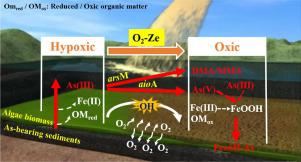Water Research ( IF 12.8 ) Pub Date : 2021-09-11 , DOI: 10.1016/j.watres.2021.117657 Ying Tang 1 , Meiyi Zhang 2 , Jing Zhang 2 , Tao Lyu 3 , Mick Cooper 4 , Gang Pan 5

|
The arsenic (As)-bearing eutrophic waters may suffer from the dual conditions of harmful algal blooms and release of As, driven by algal-induced hypoxia/anoxia. Here, we investigate the use of interfacial oxygen (O2) nanobubble technology to combat the hypoxia and control As exposure in simulated mesocosm experiments. It was observed that remediation of algal-induced hypoxia at the sediment-water interfaces (SWI) by application of O2 nanobubbles reduced the level of dissolved As from 23.2 μg L−1 to <10 μg L−1 and stimulated the conversion of As(III) to the less toxic As(V) (65–75%) and methylated As (10–15%) species. More than half of the oxidation and all the methylation of As(III) resulted from the manipulation by O2 nanobubbles of microbes responsible for As(III) oxidation and methylation. Hydroxyl radicals were generated during the oxidation of reductive substances at the SWI in darkness, and should be dominant contributors to As(III) abiotic oxidation. X-ray absorption near-edge structure (XANES) spectroscopic analysis demonstrated that surface sediments changed from being sources to acting as sinks of As, due to the formation of Fe-(hydr)oxide. Overall, this study suggests that interfacial O2 nanobubble technology could be a potential method for remediation of sediment As pollution through the manipulation of O2-related microbial and geochemical reactions.
中文翻译:

利用界面氧纳米气泡技术修复沉积物降低砷毒性
含砷 (As) 的富营养化水域可能遭受有害藻类大量繁殖和由藻类引起的缺氧/缺氧驱动的 As 释放的双重条件。在这里,我们研究了使用界面氧 (O 2 ) 纳米气泡技术来对抗缺氧和控制模拟中世界实验中的砷暴露。据观察,通过应用 O 2纳米气泡修复沉积物 - 水界面(SWI)处藻类诱导的缺氧将溶解的 As 水平从 23.2 μg L -1 降低到 <10 μg L -1并刺激 As 的转化(III) 到毒性较小的 As(V) (65–75%) 和甲基化 As (10–15%) 物种。As(III)一半以上的氧化和全部甲基化是由O 2操纵引起的负责 As(III) 氧化和甲基化的微生物纳米气泡。羟基自由基是在黑暗中 SWI 处还原物质氧化过程中产生的,应该是 As(III) 非生物氧化的主要贡献者。X 射线吸收近边结构 (XANES) 光谱分析表明,由于形成了 Fe-(氢氧化物)氧化物,表层沉积物从 As 的源转变为 As 的汇。总的来说,这项研究表明,界面 O 2纳米气泡技术可能是一种通过操纵 O 2相关微生物和地球化学反应来修复沉积物 As 污染的潜在方法。



























 京公网安备 11010802027423号
京公网安备 11010802027423号